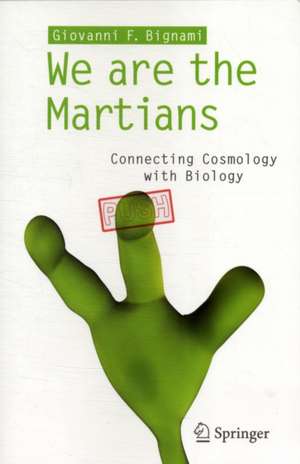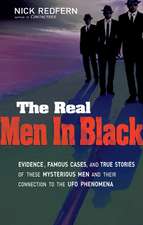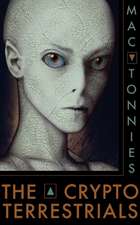We are the Martians: Connecting Cosmology with Biology
Autor Giovanni F. Bignamien Limba Engleză Paperback – 7 iun 2012
Preț: 152.58 lei
Nou
Puncte Express: 229
Preț estimativ în valută:
29.20€ • 31.22$ • 24.34£
29.20€ • 31.22$ • 24.34£
Carte disponibilă
Livrare economică 27 martie-10 aprilie
Preluare comenzi: 021 569.72.76
Specificații
ISBN-13: 9788847024656
ISBN-10: 884702465X
Pagini: 240
Ilustrații: XXIII, 128 p. 22 illus.
Dimensiuni: 155 x 235 x 15 mm
Greutate: 0.23 kg
Ediția:2012
Editura: Springer
Colecția Springer
Locul publicării:Milano, Italy
ISBN-10: 884702465X
Pagini: 240
Ilustrații: XXIII, 128 p. 22 illus.
Dimensiuni: 155 x 235 x 15 mm
Greutate: 0.23 kg
Ediția:2012
Editura: Springer
Colecția Springer
Locul publicării:Milano, Italy
Public țintă
Popular/generalCuprins
Overture: Man vs. The Universe : the Match.- Let’s build the Universe - light and matter.- Let’s build the rest of the Universe.- Astronomy in search of alien.- Contact astronomy: the Universe invading us.- Contact astronomy: we, the invaders.- Contact astronomy: comets and their dust.- Building from bricks: what is life?.- Anyone out there?-Coda: What remains to be discovered?.
Recenzii
From the reviews:
“This book is ideal for general readers who would like a simplified overview of some of the hot topics and issues in cosmology and ‘contact astronomy’. … it offers facts and theories, as well as open-to-thought ideas on origins. … A large slice of the book reiterates pivotal theories as to what happened after the beginning of the Universe. … A further topic of this book is the possibility of developed forms of life and technological civilizations beyond the Solar System.” (P. Chapman-Rietschi, The Observatory, Vol. 133 (1233), April, 2013)
“In We are the Martians Professor Bignami connects Cosmology with Biology through a 13.7 billion year journey from the first few minutes after the Big Bang … to the formation of planetary systems from embryonic protoplanetary discs. The book goes on to explore exo-planets discovered around other stars and their means of discovery. … The author has done an excellent job of keeping difficult subjects understandable and in doing so has created a thought provoking work that is a joy to read … .” (Paul Rumsby, Best Astronomy Books, September, 2012)
“This book is ideal for general readers who would like a simplified overview of some of the hot topics and issues in cosmology and ‘contact astronomy’. … it offers facts and theories, as well as open-to-thought ideas on origins. … A large slice of the book reiterates pivotal theories as to what happened after the beginning of the Universe. … A further topic of this book is the possibility of developed forms of life and technological civilizations beyond the Solar System.” (P. Chapman-Rietschi, The Observatory, Vol. 133 (1233), April, 2013)
“In We are the Martians Professor Bignami connects Cosmology with Biology through a 13.7 billion year journey from the first few minutes after the Big Bang … to the formation of planetary systems from embryonic protoplanetary discs. The book goes on to explore exo-planets discovered around other stars and their means of discovery. … The author has done an excellent job of keeping difficult subjects understandable and in doing so has created a thought provoking work that is a joy to read … .” (Paul Rumsby, Best Astronomy Books, September, 2012)
Notă biografică
Professor Giovanni Fabrizio BIGNAMI is a physicist and astronomer. Over the last 40 years he has carried out research in astronomy, from the ground and from space. A professor of astrophysics at IUSS, Pavia, he has been President of the Italian Space Agency and is now the President of COSPAR, the world-wide Committee on Space Research. He is President of The National Institute for Astrophysics (INAF) and has received various awards, including the Rossi Prize of the American Astronomical Society, the Blaise Pascal Medal of the European Academy of Sciences and the von Karman Award of the International Astronautics Academy. Professor Bignami is one of the most authoritative scientists in astrophysical and space research and identified the neutron star "Geminga."
Textul de pe ultima copertă
What frightens you more? Believing you are alone in the universe or rather thinking that there’s someone else out there?
Human beings have been asking themselves this question for many thousands of years while looking at the starry sky. Over the past few decades, however, we have moved from imagination to action, exploring the cosmos using new techniques, often with surprising results. Did you know, for instance, that every year many rocks from Mars fall on the Earth? Or that one of our amino acids has been found in the coma of a comet? Or that we now know of thousands of extrasolar planets, some of them similar to our own?
There are further exciting and important discoveries around the corner that will cast more light on the great enigma of how life started on Earth. In this intriguing book, one of the world’s leading researchers in astrophysics and space science examines fundamental questions concerning life on Earth and the rest of the cosmos in an accessible and stimulating way.
Human beings have been asking themselves this question for many thousands of years while looking at the starry sky. Over the past few decades, however, we have moved from imagination to action, exploring the cosmos using new techniques, often with surprising results. Did you know, for instance, that every year many rocks from Mars fall on the Earth? Or that one of our amino acids has been found in the coma of a comet? Or that we now know of thousands of extrasolar planets, some of them similar to our own?
There are further exciting and important discoveries around the corner that will cast more light on the great enigma of how life started on Earth. In this intriguing book, one of the world’s leading researchers in astrophysics and space science examines fundamental questions concerning life on Earth and the rest of the cosmos in an accessible and stimulating way.
Caracteristici
Covers fundamental questions concerning life on Earth and the rest of the cosmos Presents and discusses information in an accessible and stimulating way Written by one of Europe’s leading researchers in astrophysics and space science Includes supplementary material: sn.pub/extras









